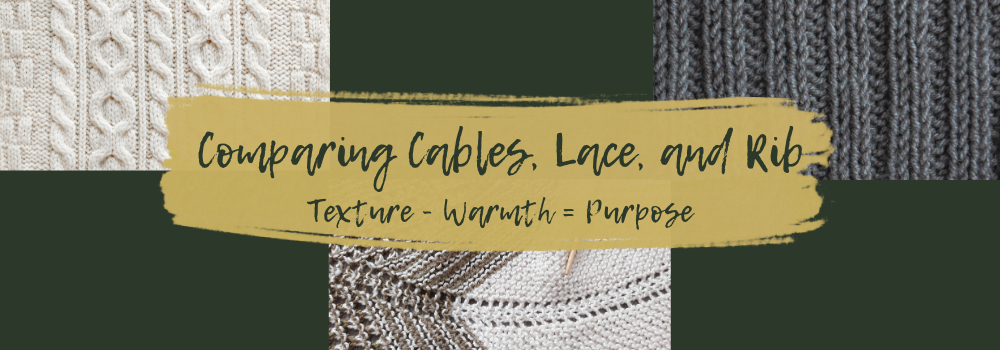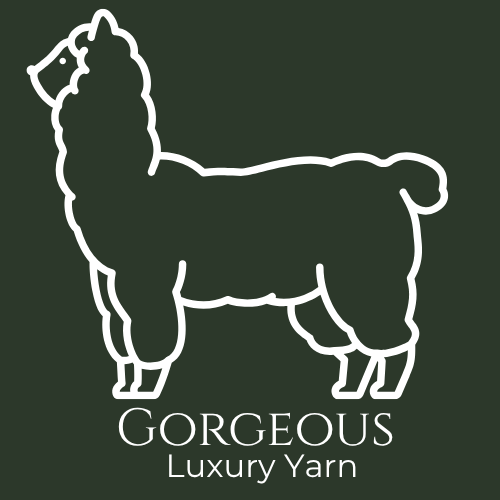
Choosing Texture: Cables v. Lace v. Rib for Warmth
Share
When knitters talk about their favourite projects, they’ll often mention colour, yarn type, or the pattern they followed. But one design element is just as important — texture. The stitch patterns you use don’t just shape the look of your garment, they also change the way it feels, drapes, and how much warmth it provides.
Whether you’re planning a chunky winter jumper, a light and breezy shawl, or a snug pair of socks, choosing between cables, lace, and ribbing will make a big difference to the finished piece. In this blog, we’ll explore how each of these popular textures affects warmth, share when to use them, and give practical tips for bringing them into your next project.
Why Texture Matters in Knitting
Texture creates more than just visual interest. By changing the structure of stitches, you can trap heat, add breathability, or create elasticity. Think of texture as the “architecture” of your knit — it determines whether your fabric is dense and insulating, or light and airy.

If you’re new to knitting design, this is the perfect area to experiment. Even simple projects can be transformed by switching to a textured stitch pattern.
🧶 Cables: Classic, Cosy, and Insulating
Cables are among the most recognisable stitch patterns in knitting. By crossing stitches over one another, you create raised, rope-like patterns that instantly add depth and complexity.
Warmth Factor: High. The overlapping stitches form thicker fabric, which traps air and locks in heat.
Best Uses:
- Winter jumpers and cardigans
- Chunky scarves and cowls
- Cosy blankets
- Hats that need extra insulation
Style Note: Cables are bold and traditional, perfect for a heritage-inspired look.
✨ Pro Tip: Cables shine in alpaca yarns because the natural softness adds luxury while the definition makes each twist stand out.

🌿 Lace: Light, Airy, and Elegant
Lace knitting might be associated with delicate shawls, but it’s surprisingly versatile. The deliberate holes created by yarn overs form intricate patterns that are breathable and decorative.
Warmth Factor: Low. Lace is about openness and airflow, which makes it perfect for layering.
Best Uses:
- Summer wraps and shawls
- Lightweight scarves
- Decorative panels in tops or cardigans
- Special-occasion knits
Style Note: Lace adds romance and grace, and its drape is especially beautiful in fibres with a natural sheen.
✨ Pro Tip: Block lace carefully. It opens up the design and gives your project a professional finish.

👉 Related Reading: Blocking Knitting – Why It Matters
✨ Rib: Stretchy, Snug, and Versatile
Ribbing is created by alternating knit and purl stitches. While many knitters know it as the edging on jumpers and socks, ribbing can also make up an entire garment.
Warmth Factor: Medium. The structure hugs the body, holding warmth without bulk.
Best Uses:
- Socks and mittens
- Hats with stretch
- Fitted jumpers and tops
- Cuffs, hems, and necklines
Style Note: Ribbing is practical, clean, and classic. It works well on its own or as a supporting texture.
✨ Pro Tip: For extra warmth, try Fisherman's Rib or Brioche with alpaca wool. It creates a springy fabric that stays snug and cosy.

👉 Related Reading: How to Store Your Wool & Projects Safely
Comparing Cables, Lace, and Rib
Here’s a quick side-by-side to help you decide which texture is best for your project:
Fibre Matters Too
While stitch texture is important, the yarn itself also plays a role in warmth. Natural fibres like alpaca and wool trap air more effectively than cotton or synthetic blends. Alpaca, in particular, is known for being warmer than sheep’s wool while still breathable — making it an excellent match for all three textures.
For a deeper dive, see this great BBC video and article.
Bringing It All Together
So, how do you choose?
- For maximum warmth: Cables are your best friend.
- For a light and breezy fabric: Lace is perfect.
- For balance and flexibility: Ribbing is the way to go.
Mixing textures in one project is also a smart approach — ribbed cuffs on a cabled jumper, or a lace panel in a ribbed top. The combinations are endless and allow you to tailor warmth exactly where you need it.
Final Thoughts
Texture is more than just decoration — it changes the way your project feels, functions, and keeps you warm. By experimenting with cables, lace, and rib, you’ll discover how to match stitch patterns to your lifestyle and the seasons.
Ready to try it for yourself? Explore our collection of soft, ethically sourced alpaca yarns, trusted by knitters across the UK and Ireland. Whether you’re making a chunky cable jumper, a lace shawl, or a ribbed hat, alpaca wool will bring your texture to life.

